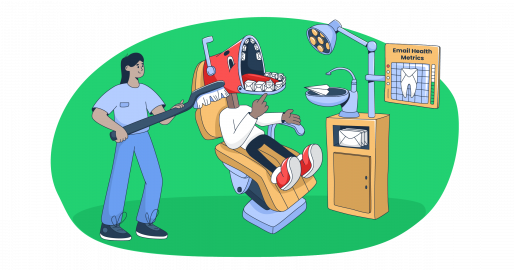What do teeth and inboxes have in common? If you don’t check them regularly, things get ugly.
This article is about email marketing for dentists — why it matters, and how to do it well. Whether you’re managing a solo clinic or scaling a group practice, we’ll show you what campaigns to run and how to write them, as well as when it makes sense to work with an agency.
What is email marketing for dentists?
Email marketing for dentists involves sending targeted, useful emails to your current and prospective patients. You want to keep your practice in people’s minds and make sure they book regular appointments. While you may have other goals too like confirming patient details for account reconciliation, your practice’s email list will typically be used for:
- Sending appointment reminders
- Sharing pre- or post-treatment information
- Educating patients on oral health
- Reactivating patients who haven’t booked in a while
- Encouraging referrals and building a community
To stress, this isn’t about spamming inboxes with discounts. It’s about sending the right message at the right time. That might mean a friendly check-up reminder or even an educational post-op guide.
Most dental practices already collect emails through intake forms. The mistake is to stop at that. A good email marketing strategy turns that list into an engine for retention and referrals.
5 email marketing campaigns for dentists
Wondering how to get started? Here are the five core types of email campaigns every dental practice should build and run regularly.
Appointment reminders
These are your front line against missed appointments and empty chairs. A well-timed reminder email 24-48 hours before the appointment can help you reduce no-shows and provide important info about the visit.
You should include:
- Appointment time and date
- Location and parking tips
- A “Confirm” or “Reschedule” button
- Contact info if they have questions
Pro tip: Add SMS reminders as a second layer of defense against missed appointments. Patients are more likely to see text messages for same-day alerts.
Welcome emails for new patients
You’ve just had a new patient sign up for your practice or book an appointment. Rather than waiting for them to contact you, set expectations with a welcome email and make them feel confident about their decision.
Of course, that email should be sent immediately after booking.You can automate it through a customer relationship management (CRM) or email platform, rather than having to time it manually.
What to include:
- A thank-you message from the dentist
- What to bring to their first visit (insurance card, forms)
- Link to new patient paperwork
- Link to Google/Yelp reviews
- Meet the team / virtual tour of the office
Why is this so important?
A good welcome email builds loyalty early and helps reduce first-visit no-shows. And let’s face it, no matter how nice your practice is, going to the dentist is a nerve-wracking thing for many people. Introducing yourself in advance can go a long way towards helping patients be comfortable in your care.
Reactivation campaigns
Lapsed patients cost you money, and the longer they go without visiting, the harder it is to bring them back. A good reactivation email can nudge them before it’s too late. These emails should have:
- A personalized subject line: “We haven’t seen you in a while, [First Name]”
- A friendly tone that’s not pushy
- A reason to return (seasonal check-up, insurance reset, new services, or even a special offer)
- A clear “Book Now” button
Sending these emails shouldn’t be a one-off task. Instead, stagger them over a period of time. Sending one, 6, 9, and then 12 months after the patients’ last visit is a good starting point. That way, you’ll be on their mind, but avoid coming across as spam.
Educational newsletters
Newsletters are a simple email marketing strategy to keep your patients informed and engaged. A monthly or bi-monthly email with dental health tips, FAQs, product recommendations, or even fun facts can go a long way.
Here are some newsletter ideas:
- What to do after a tooth extraction
- Best whitening toothpastes (with dentist’s picks)
- Foods that are secretly bad for teeth
- How often to replace a toothbrush
- Staff highlights or fun photos from the office
A regular email newsletter can also be part of a wider content marketing strategy, linking to blog posts or social media accounts too. Make sure to add a clear call to action at the end, for instance, “Ready to book your next cleaning?” and remember, your target audience won’t have the same in-depth knowledge that you do.

Referral emails
Patients trust their friends more than your ads. In fact, almost 90% of consumers trust personal recommendations more than any other advertising channel. That’s why referral emails are essential for conversions.
Create an automated email campaign that goes out at a set period of time after an appointment asking for referrals. Timing is key, and you want to ask when patients are most satisfied. For a short cleaning appointment, this might be the next day. For a complex, multi-appointment course of treatment, this might be after the final check-up.
Consider asking for testimonials you can post on your website for new customers to see as social proof. You can even offer a reward — free whitening or a discount, for example.
Do dentists need email marketing?
In short: yes! If you’re not using it, you’re falling behind.
Here’s why:
- It works. Email marketing is incredibly cost-effective and has a strong return on investment (ROI). You can get $36 back for every dollar spent. That’s higher than other marketing channels like paid ads and social media.
- It’s low-maintenance. Once you set up automation, your campaigns can run on their own.
- Patients expect it. This is particularly true of reminders, as well as follow-ups and post-op instructions.
- It keeps your schedule full. Reactivation and reminder campaigns are a useful way to prevent a day of empty chairs.
- It’s better than social media. Ultimately, social posts don’t reach everyone. You’ll have plenty of patients who don’t have social media or simply don’t follow you. But emails land directly in inboxes.
Put simply, if you’re running a dental practice and not using email marketing, you’re missing easy wins.
8 dentist email marketing tips and best practices
Here’s how to do dentist email marketing well. Don’t worry, you don’t need to be a marketing specialist (though their advice might help).
Write like a patient, not a dentist
Your patients have never studied dentistry, and they shouldn’t need one to understand your emails, especially if you want to build trust. Keep your language clear and friendly, and avoid clinical or terms unless you’re sure your audience understands them.
Why it matters: Emails that sound cold or overly professional tend to be ignored. People respond to warmth and clarity.
So instead of: “Your prophylactic cleaning is overdue”, say: “You’re due for your 6-month cleaning. Ready to book?”
Tips:
- Use contractions (like “you’re” instead of “you are”) to sound more conversational.
- Imagine writing to a friend who hasn’t been to the dental clinic in a while.
- Read your email out loud, and if it sounds stiff, rewrite it with a paraphrasing tool.
Design for mobile first
Lots of your current patients are reading emails on their phones (64% on average). If your email isn’t easy to read on a small screen, they’ll delete it — or worse, send it to spam.
Mobile-first design essentials:
- Use a single-column layout to keep things clean and easy to follow.
- Include large buttons that can be tapped with a thumb.
- Keep subject lines under 50 characters to avoid them being cut off.
- Use a font size of at least 14px, as smaller text can be unreadable on phones.
- Test your emails on a mobile device, and always preview how it looks before hitting send.
- Add white space around email content blocks to prevent clutter and make scanning easier.
Segment your list
Don’t send the same message to everyone. Instead, tailor your emails to different groups of patients so you can send the most relevant message to the right people. A good email marketing tool can make this process easy for you.
Useful patient segments:
- New patients. Target this group with welcome emails and first-visit tips.
- Lapsed patients can be sent win-back campaigns or special offers.
- Patients with upcoming procedures should be sent pre-op instructions and what to expect
- Parents should get family-focused content, such as pediatric cleaning reminders and child-friendly tips.
You can even break these down further – for instance, patients who have previously had fillings through you might get different care tips to those who haven’t. If you pick the right segments, and the right content, personalized emails can lead to higher open rates and click-throughs.
After all, people are more likely to act when a message feels relevant to them.
Track the right metrics
While automation can make email marketing low-maintenance, it shouldn’t be a case of “set it and forget it.” Instead: check your performance regularly so you can adjust and improve. You can usually see these metrics on the dashboard of your chosen email marketing platform.
| Metric | What it Tells You |
| Open Rates | How effective your subject lines and sender name are |
| Click Through Rates | Whether your message and call to action are engaging |
| Bounce Rates | If your list has outdated or bad email addresses |
| Unsubscribe Rates | If you’re sending too often or targeting the wrong people |
You can use these results to improve your campaign, for instance:
- If open rates are low, A/B test subject lines or try a different sender name.
- If click rates or conversion rates are low, tweak your CTA. You can try to make it clearer or even simply more visible.
- Keep your list clean and remove inactive addresses to improve bounce rates.
Stay HIPAA-compliant
Any email that contains personal health information (PHI) must follow HIPAA guidelines. You must stay compliant at all times, so don’t let your excitement for your new email campaign distract you from legal matters.
Key HIPAA email rules are:
- Don’t include PHI: Avoid naming test results or conditions in emails.
- Get consent: Only email patients who have opted in to marketing messages.
- Use HIPAA-compliant platforms if you must include sensitive info.
- Stick to general info like appointment reminders and office updates.
Pro tip: When in doubt, leave it out. Keep promotional emails general, and use secure patient portals or phone calls for anything private.
Automate everything you can
Email automation saves you time and helps you stay consistent. You can set up workflows that run in the background and keep patients engaged without constant manual effort.
Here are some common dental emails that can be sent out automatically:
- Appointment reminders
- Birthday emails
- Appointment follow-up emails with post-op instructions
- New patient welcome series
- Reactivation campaigns
Keep your branding consistent
Your emails should look and sound like you. Whether you’re warm and welcoming or sleek and professional, keep it consistent across every message. This starts with the email address you’re sending your messages out from. Does it end in something like @gmail.com, or @aol.com? That’s immediately disconnected from your online presence. See if your web hosting provider offers custom business emails, or use a solution like Google Workspace to create a branded address.
Beyond this, some essential branding basics include:
- Logo: At the top or bottom of every email
- Colors and fonts: Match your dental website and signage
- Tone of voice: Friendly? Funny? Reassuring? Use it every time
- Footer: Include contact info and social links as well as an unsubscribe option
This consistency isn’t just important for email campaigns. You should have the same branding wherever you have a presence, including your own website, social media accounts, and in-office leaflets.
Work with a dental-savvy email marketing agency
You simply might not have time to build campaigns, segment lists, or monitor metrics like email deliverability or click rates. In this case, partnering with an email marketing agency can be a smart move. But don’t just hire the first digital marketing firm you find. Look for one with healthcare or dental experience.
Key factors to consider include:
- A track record working with healthcare providers. Ask for case studies or referrals.
- HIPAA knowledge and a clear commitment to data protection and privacy. They should be aware your subscriber list is opt-in only.
- Clear deliverables. They should clearly present what they’ll provide: strategy, copywriting, automation setup, and reporting.
- Flexible pricing and scalable plans. This is particularly important if you’re a small practice.
3 Dentist office email marketing templates
Writing targeted emails doesn’t come naturally for everyone. Don’t worry – we’ve got you covered. Here are some real-world email templates you can copy and adapt.
Template: Appointment Reminder
| Subject: Your appointment is coming up — see you soon! Hi [First Name], Just a quick reminder — you have an appointment with us on: [Date] at [Time] [Location, with a link to Google Maps] If you need to reschedule, click here: [Reschedule Link] We look forward to seeing you! [Your Practice Name] |
Template: Post-Op Instructions
| Subject: How to care for your smile after [Procedure] Hi [First Name], Thanks for visiting us today. Here’s how to take care of your smile after your [Procedure]: – Avoid hard or hot foods for 24 hours – Rinse with warm salt water 2–3 times a day – Take any prescribed meds as directed Got questions? Just reply or call [Phone Number]. We’re here to help. Take care, [Your Practice Name] |
Template: Birthday Greeting + Offer
| Subject: Happy Birthday from [Your Practice Name]! Hi [First Name], Wishing you a wonderful birthday! To celebrate, we’re giving you 10% off any whitening treatment. Just book within the next 30 days using the link below. [Book an Appointment Now] Hope you have a fantastic year! |
Wrapping up
Dental email marketing is essential. With the right strategy, you’ll book more appointments, build strong patient relationships, and free up your staff from tedious admin tasks.
And if you’d rather not do it all yourself? Bring in an expert. Whether you use in-house tools, hire a freelancer, or partner with an agency, email marketing can transform your practice from good to great.
Now open your inbox and get to work. Your patients are waiting.



